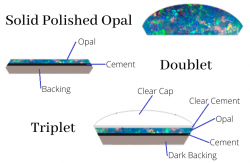Opals, Doublets & Triplets

Once mined, solid pieces of Opal are cut and polished to emphasise the stone's pattern, intensity and colour play, and create the beautiful stones we see in jewellery.
However, Opals also often occur as thin seams through rock. Although still most beautiful, some deposits are just too thin to use in jewellery. This is when doublets and triplets become useful, helping to make these thin slices of Opal stronger, and able to be set into rings, earrings etc.
Doublets - One of these thin Opal layers are cemented onto a strong dark backing, such as black onyx, black potch, plastic, glass or something similar. This creates a strong base, so the Opal can be set. The Opal layer in doublets are usually thicker than what you would find in a triplet, and usually have rounded off edges to give the whole stone a cabochon look.
Triplets - These usually use very thin slivers of Opal, sandwiched between 2 other layers. Opal triplets have a clear, usually domed, cap cemented to the top of the slice of Opal, with the same backing as a doublet. Usually caps are made of tough, scratch resistant materials, like rock crystal Quartz, synthetic colourless Spinel, or even synthetic colourless Sapphire. Triplets are normally cheaper than doublets because they contain less real Opal, but can be a lot more resistant to impact than solid or doublet opal stones, due to the protective cap.
For both doublets and triplets, the darker backing emphasizes the play of colour in the slice of Opal, and is much more attractive than with a lighter backing.